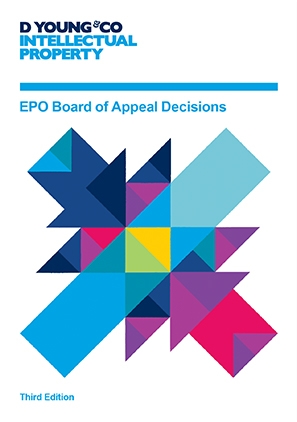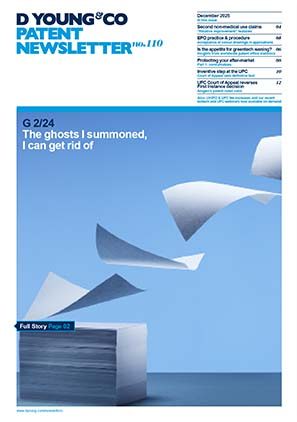G1/16: door open for undisclosed disclaimers at EPO
The Enlarged Board of Appeal has now released its written decision in respect of G 1/16 (T 0437/14). This decision resolves the question regarding which standard is to be applied to determine whether an “undisclosed disclaimer” in a patent claim introduces added subject-matter (that is, it contravenes Article 123(2) EPC).
Previously G 1/03 and G 2/10 have both addressed issues regarding added subject-matter of disclaimers; this is therefore the third Enlarged Board of Appeal decision to be issued in just over a decade on this subject, which perhaps gives an indication of how contentious an issue the allowability of introducing disclaimers into patent claims is seen to be at the EPO.
Background – undisclosed v disclosed disclaimers
In general, patent claims typically define the subject-matter for which protection is sought in terms of “positive” technical features of the claimed invention; meaning those technical features that define the elements and characteristics of the claimed subject-matter.
In contrast, a “disclaimer” was defined in G 1/03 as meaning an amendment to a claim resulting in the incorporation of a “negative” technical feature, typically excluding from a generally defined subject-matter specific embodiments or areas.
For example, a claim may define its subject-matter by the following positive features: “A composition comprising a metal”.
However, it is also possible to define the claimed subject-matter in terms of “negative features”; for example, by introducing the feature that “the metal is not tin”. This sort of amendment can be illustrated as shown below:

This is known as a disclaimer since what is left in the claim is less than that before the introduction of the negative feature.
G 1/16 is concerned with the distinction between two types of disclaimer: a “disclosed disclaimer” and an “undisclosed disclaimer”.
An undisclosed disclaimer refers to a disclaimer which is not disclosed in the application as filed, and nor is there any disclosure of the subject-matter excluded by it in the as-filed application; it is a disclaimer that excludes subject-matter that is not specifically mentioned in the application as filed. Using the above example of “metal – tin”, this would be an undisclosed disclaimer in the case where there is simply no mention of tin anywhere in the application as filed.
In contrast, a disclosed disclaimer refers to a disclaimer which may not itself have been disclosed in the application as filed, but the subject-matter excluded by it is disclosed in the application as filed; it is a disclaimer that excludes subject-matter that is specifically mentioned (disclosed) in the application as filed, such as in an embodiment or example. Again, using the above example of “metal – tin”, a situation in which there is an example in the application as filed of the metal being tin would constitute this disclaimer being a disclosed disclaimer.
G 1/03 – Allowability of undisclosed disclaimers under Article 123(2) EPC
G 1/03 first dealt with the question of allowability under Article 123(2) EPC of undisclosed disclaimers. In G 1/03, the Enlarged Board of Appeal held that an amendment to a claim by the introduction of a disclaimer may not be refused under Article 123(2) EPC for the sole reason that neither the disclaimer, nor the subject-matter excluded by it from the scope of the claim, have a basis in the application as filed. However, such an undisclosed disclaimer is only allowable in certain, limited circumstances; namely, in order to:
- Restore novelty against art under Article 54(3) EPC;
- Restore novelty over an accidental anticipation; or
- Disclaim subject-matter that is excluded from patentability for non-technical reasons under Articles 52 to 57 EPC.
It was thus clear that undisclosed disclaimers could only be introduced if the limitation does not contribute to the invention – it must not become relevant for assessment of inventive step or sufficiency. Furthermore, it was held that a disclaimer may only serve the purpose for which it is intended and nothing more; meaning it cannot disclaim more than is necessary to restore novelty or disclaim the non-technical subject-matter.
G 2/10 – Allowability of disclosed disclaimers under Article 123(2) EPC
Several years later, G 2/10 addressed a different question of whether a disclaimer infringes Article 123(2) EPC if its subject-matter was disclosed as an embodiment of the invention in the application as filed. In other words, G 2/10 was concerned with the question of allowability of disclosed disclaimers.
In G 2/10, the Enlarged Board of Appeal held that an amendment to a claim by the introduction of a disclosed disclaimer infringes Article 123(2) EPC if the subject-matter remaining in the claim after the introduction of the disclaimer is not, be it explicitly or implicitly, directly and unambiguously derivable from the application as filed. This therefore confirmed that the application of the “gold standard” for assessing added matter (what the skilled person would directly and unambiguously derive from the application as filed) of disclosed disclaimers.
A number of commentators have considered that this was seemingly in conflict with the decision in G 1/03. There followed a divergence in applicability of G 2/10 to undisclosed disclaimers: in a number of decisions, Boards applied the gold standard test of G 2/10 to undisclosed disclaimers in addition to the criteria set out in G 1/03, whilst in some cases the allowability was primarily assessed on the basis of the gold standard alone.
The question of which standard should be applied for undisclosed disclaimers was therefore referred to the Enlarged Board for consideration in G 1/16.
G 1/16 decision
In G 1/16, the Enlarged Board has confirmed that the criteria set out in G 1/03 are to be applied when considering whether a claim amended by the introduction of an undisclosed disclaimer is allowable under Article 123(2) EPC. The gold standard test of G 2/10 is not the relevant test for examining whether an undisclosed disclaimer complies with Article 123(2) EPC.
The Enlarged Board of Appeal did, however, note that the gold standard defined in G 2/10 still remains the relevant test for assessing allowability of the introduction of a disclosed disclaimer.
Reasoning
Fundamental to the Enlarged Board of Appeal’s decision was the inherent conceptual differences which exist between disclosed and undisclosed disclaimers. Indeed, the Enlarged Board of Appeal noted that, by virtue of what an undisclosed disclaimer is, when neither the disclaimer itself nor the subject-matter excluded by it is disclosed in the application as filed, it automatically follows that the subject-matter remaining in the claim after the introduction of such an undisclosed disclaimer can hardly have been considered to be derivable from the application as filed.
The Enlarged Board of Appeal held that: “It follows from the above that the choice of the proper test … is determined by the fundamental distinction between disclosed and undisclosed disclaimers. That distinction necessitates providing for each of the two classes of disclaimer a single specific test for assessing whether the introduction of a given disclaimer is in compliance with Article 123(2) EPC. For undisclosed disclaimers, the proper test is whether the criteria of G 1/03 are fulfilled, and for disclosed disclaimers the proper test is the gold standard disclosure test of G 2/10”
In arriving at this decision, the Enlarged Board of Appeal also noted that the idea underlying Article 123(2) EPC is that the applicant should not be given an unwarranted advantage, and precludes a new technical contribution being added by an amendment. G 1/03 was considered not to be in contradiction with this premise.
Conclusion
This decision has clarified that the door is not being shut entirely on the use of undisclosed disclaimers. This provides some relief as it will therefore still be possible for applicants to introduce undisclosed disclaimers where necessary in order to exclude prior art that is either an accidental anticipation or post-published, or in order to exclude non-technical features.
Of course, it still needs to be borne in mind that the criteria for allowability of undisclosed disclaimers under Article 123(2) EPC is very restricted. Applicants should therefore continue to draft applications with sufficient fall-back positions, preferably in terms of positive features, that allow for limitations to be made during prosecution without needing to rely on the introduction of such undisclosed disclaimers. The introduction of such disclaimers should be relied on sparingly.
Case details at a glance
Jurisdiction: European Union
Decision level: Enlarged Board of Appeal
Date: 18 December 2017
European Case Law Identifier: ECLI:EP:BA:2017:G000116.20171218
Case number: G 0001/16
Referral: T 0437/14
Full decision (EPO website): http://dycip.com/g016disclaimer
Further reading
Undisclosed disclaimers - Enlarged Board of Appeal, article by Catherine Keetch, 16 December 2016.
Undisclosed disclaimers

